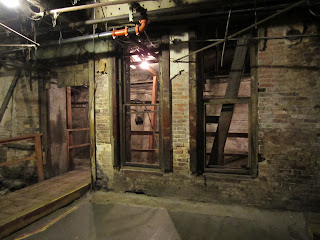The first 3 pictures are in the original first floor of a general store of the time.
 |
| These are the windows that would have looked out into the street, now it is just the side of the new street. |
This is from a butcher shop on the block. The floor is collapsing on itself, which is common for most of the original floors of the time. Being so close to the waterfront, the businesses had to build up above water level. Since dirt was not easy to come by, they often used garbage or sawdust, which were very easy to come by in a lumber community.
 |
| Collapsing floor. |
When the city finally put the sidewalks at the new street level, they build brick archways between steel beams for support.
Each block has a few glass inlays to allow light into the original sidewalk spaces.
Around the time of the fire, there was also a gold rush in the Northwest. Once prospectors found gold, it was not always safe to carry it around the streets, so they took their gold into the underground sidewalks. One bank build a vault in the underground so the prospectors could deposit their gold without walking around with it for so long.
This is the Smith Tower which was built in 1914, and was the tallest building west of the Mississippi until 1931.
 |
| Pioneer Square before the fire |
Since the sewage system was not designed well in Seattle, running water was a problem in the city. High tide came in two times a day and would engulf the drainage pipes that led to the water, causing sewage backups in homes. For years, people had charts of when the tide was high and low to determine when they could flush their toilets. The solution: the Crapper Valveless Waste Preventer.










No comments:
Post a Comment